VRSG in F-16 Simulation
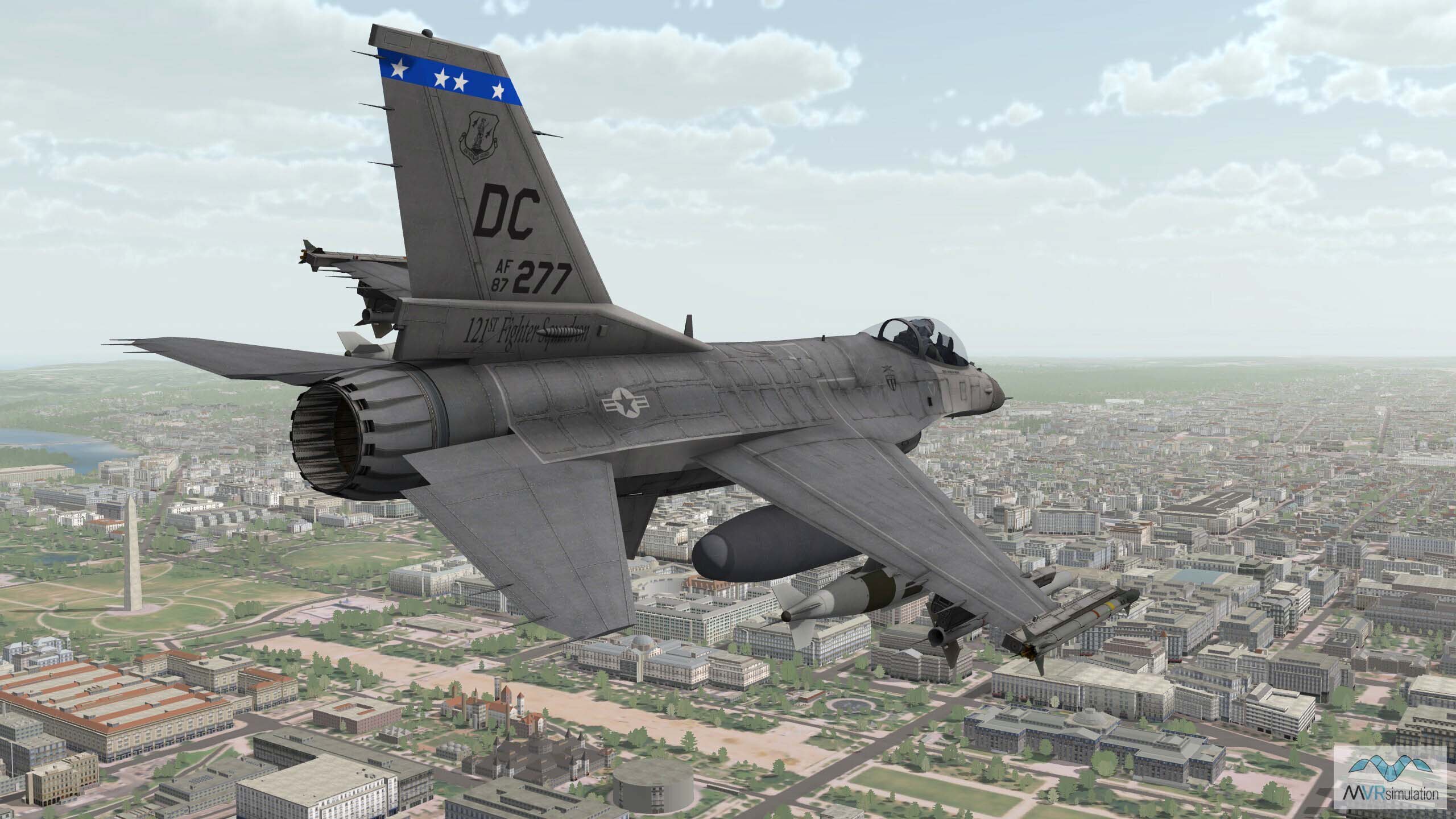
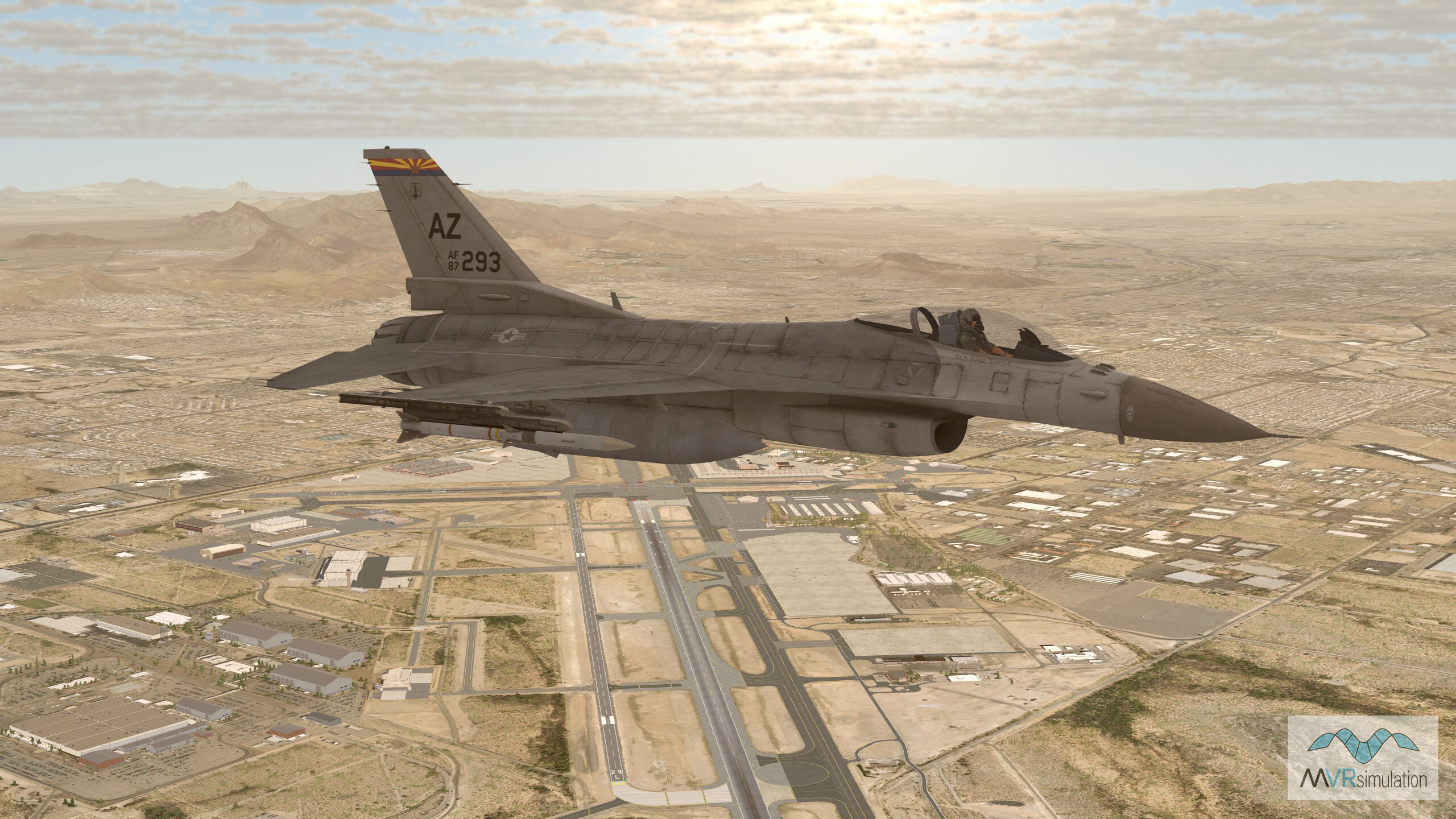
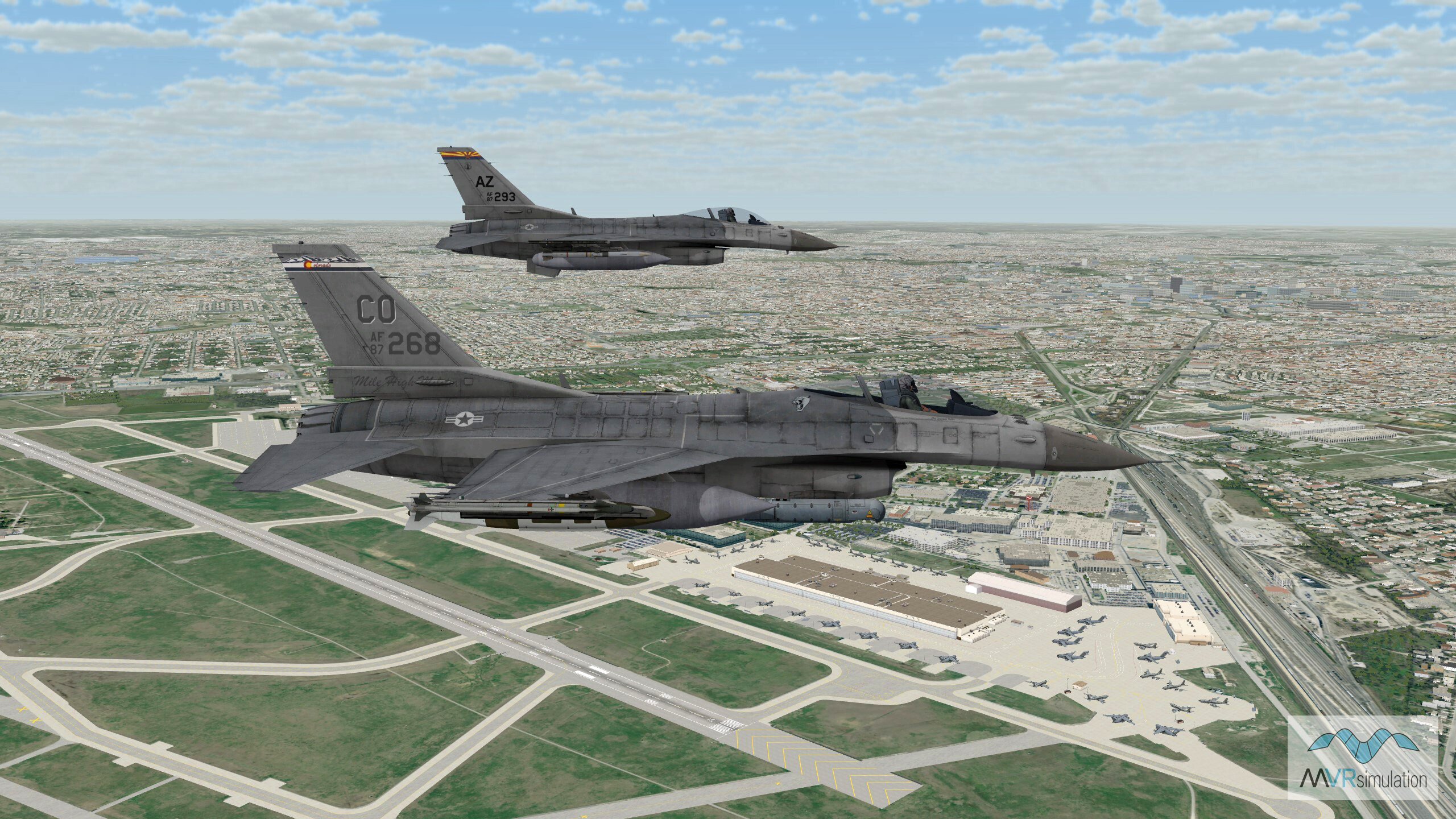
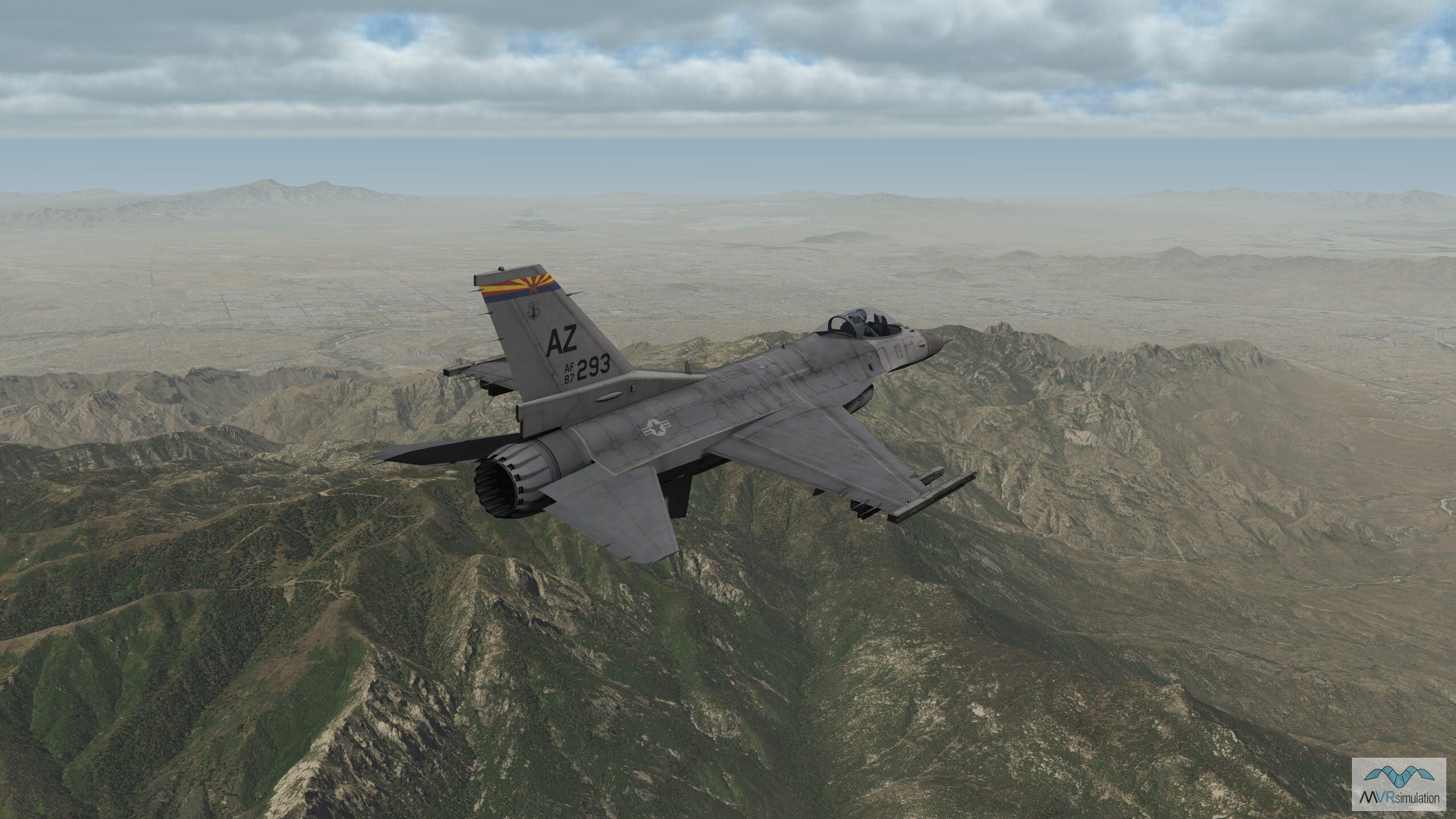
MVRsimulation VRSG is used in F-16 simulators at multiple U.S. Air Force, Air Force Reserves, and Air National Guard training facilities in the U.S. and abroad.
In 2020, a total of 301 new VRSG licenses were purchased for Air National Guard F-16 Mission Tactics Trainer (MTT) simulators. These new simulators will be fielded at sites that already use VRSG such as Tucson, AZ and Joint Base San Antonio, Lackland, TX, as well as at Andrews Air Force Base (AFB), MD. In 2022, ten new VRSG enabled F-16 Block 30 Mission Tactics Trainer (MTT) simulators were delivered to support U.S. Air National Guard and U.S. Air Force Reserve Command training at Lackland Air Force Base, and Tucson, AZ Air National Guard Base.
In the F-16 MTT, VRSG simulates multiple views: out-the-window, embedded HUD, HMD/HMIT, real-time streaming protocol (RTSP) in the central display unit, ground map radar, targeting pod, and maverick missile displays. Combined with MVRsimulation’s 3D terrain and models, the cockpit displays with native 4K (4096 x 2160) resolution offer combat pilots an immersive field-of-view that renders the out-the window virtual environment with near 20/20 visual acuity.
In 2025, two new 15x channel Air National Guard F-16 MTT simulators equipped with VRSG were delivered to Andrews Air Force Base (AFB), MD. Andrews AFB is now home to two 2-ship MTTs with a future plan of bringing them together into a network MTT 4-ship.
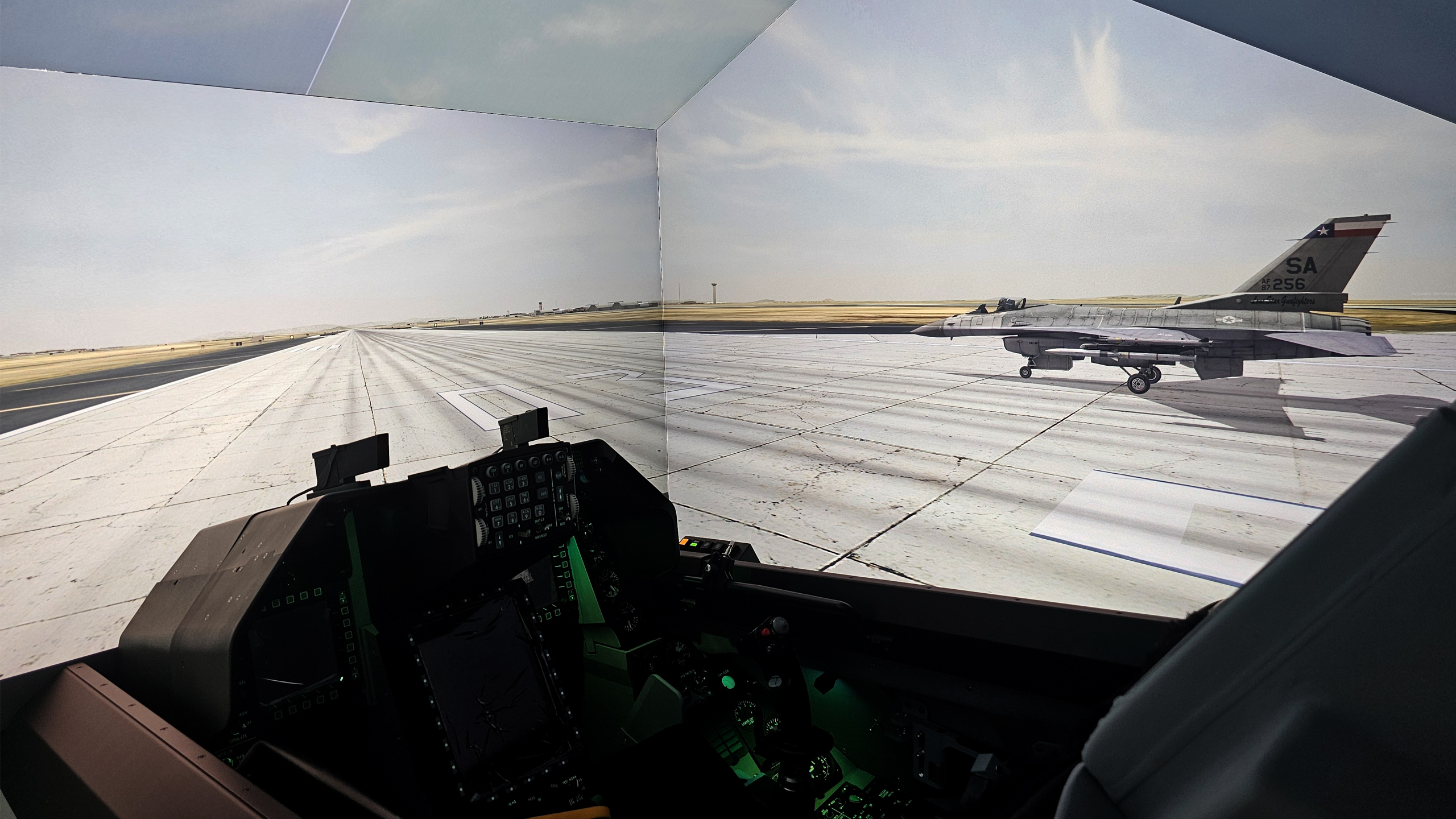
Photo of the F-16 MTT showing VRSG terrain (image courtesy of Trident Military Systems).
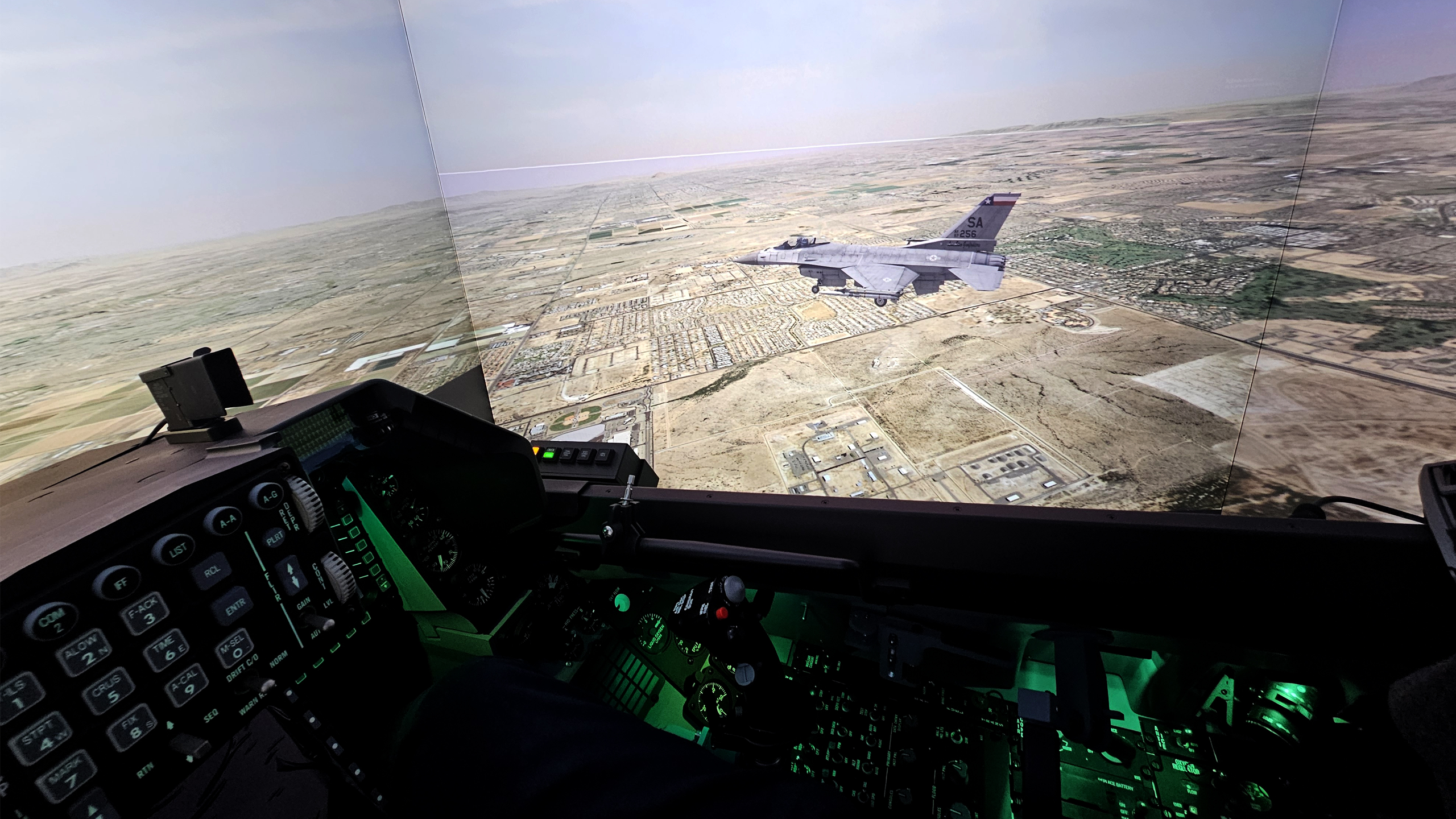
The F-16 MTT showing VRSG's San Antonio terrain (image courtesy of Trident Military Systems).
In spring 2019, the 140th Wing of the Colorado Air National Guard took delivery and installation of four F-16C Block 30 simulators with VRSG, at the new mission training center (MTC) at Buckley Air Force Base, CO.
These virtual cockpits use 60 VRSG channels to simulate multiple views: out-the-window, embedded HUD, HMD/HMIT, RTSP in the central display unit, ground map radar, targeting pod, and maverick missile displays. The simulators match the current aircraft configuration standard of F-16C Block 30 System Capabilities Upgrade 9.0 (SCU-9.0), like the ones installed with VRSG at Lackland Air Force Base and Tucson Air National Guard Base. The simulators have 8-screen cockpit displays with native 4K (4096 x 2160) resolution, for an immersive FOV that renders the OTW virtual environment with near 20/20 visual acuity.
Combat mission-ready pilots will train on these simulators to maintain proficiency and currency according to the ACC’s Design Operational Capability training.
The simulators were relocated from the Vermont Air National Guard base at Burlington International Airport (where they had previously been used for F-16 training simulation) and underwent significant upgrading prior to integration at the Buckley MTC. The MTC is housed in the newly renovated historic Hangar 909.
The 3D terrain delivered with the simulators includes MVRsimulation's replica of Buckley AFB and Greater Denver, built with MVRsimulation Terrain Tools for Esri® ArcGIS® from 15 cm per-pixel imagery of the airfield blended to 1 meter imagery of MVRsimulation's CONUS++ terrain. The terrain's elevation was built with interpolated NED 1/3 (10 m) and underlying CONUS++ DTED1. Airfield culture includes the runways, runway lights and signage, a geospecific control tower and 24 other geospecific buildings, fuel storage tanks, water towers, radars, geotypical volumetric trees, and light points. Geospecific culture models were created from publicly available photos and geolocated on the terrain. This terrain was built with the latest version of Terrain Tools. Culture models were placed with Scenario Editor. Surrounding the modeled airfield is terrain of Greater Denver, comprised of 439,379 building models which were generated with Esri CityEngine®. The terrain, including the nearby Rocky Mountains, has over 4.5 million trees. For simulating night scenes, the terrain contains thousands of cultural light points of the airfield and Greater Denver.
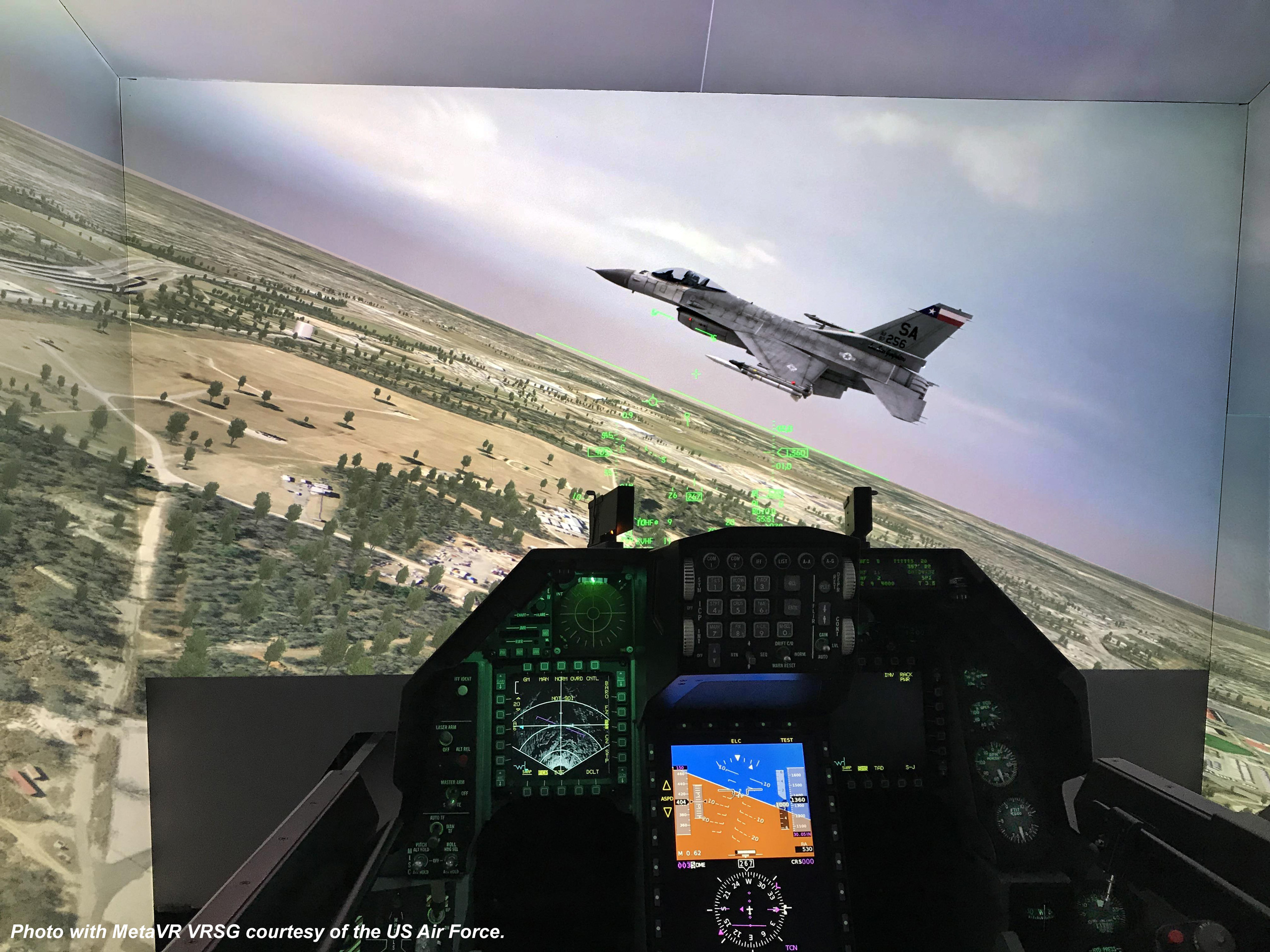
As part of the Pilot Training Next (PTN) initiative, the U.S. Air Force uses two F-16C simulators at Kelly Field, Lackland Air Force Base, San Antonio, Texas, which include VRSG, terrain, and 3D models in immersive virtual cockpits for training student pilots. In addition to use in Pilot Training Next, the simulators are being used extensively in the F-16 Basic Course syllabus.
Housed in a relocatable shelter, the 2-ship simulators use a total of 30 VRSG channels for simulating the out-the-window, embedded HUD, HMD/HMIT, real-time streaming protocol (RTSP) in the central display unit (CDU), ground map radar, targeting pod, and maverick missile displays.
It is believed that for the first time in over a decade, the 149th Fighter Wing unit at Kelly Field has F-16C Block 30 simulators that match the current aircraft configuration -- concurrent with the hardware and software of the actual aircraft F-16C Block 30 System Capabilities Upgrade (SCU) 9.0 standard. This concurrency is essential for training new student pilots such that the students train in a simulator that represents their F-16C Block 30 primary platform.
Per the sale of 301 new VRSG licenses to the Air National Guard in early 2020 for multiple F-16 simulators at sites across the U.S, more F-16 simulators running VRSG are slated to be installed at Lackland Air Force Base.
MVRsimulation has built a virtual replica of Kelly Field at Lackland Air Force Base and Greater San Antonio, from 0.15 mpp per-pixel imagery of the airfield area blended into 1 mpp underlying imagery of MVRsimulation's CONUS++ terrain. The terrain's elevation was built with interpolated 10 mpp NED of Lackland AFB, DTED 1 of San Antonio, and underlying CONUS++ DTED1. This terrain was built with Terrain Tools. Culture models were placed with Scenario Editor. Surrounding the modeled air force base is terrain of Greater San Antonio, comprised of buildings which were generated with Esri CityEngine®. For simulating night scenes, the terrain contains thousands of cultural light points of the airfield and Greater San Antonio.
The 162nd Fighter Wing of the Arizona Air National Guard uses VRSG in two reconfigurable flight simulators capable of representing either an F-16C block 30 SCU 9.0 or a block 40 M7.1 actual aircraft. The training devices incorporate a total of 30 channels of VRSG, 3D terrain, and 3D models. Pilots train on the simulators at the Tucson Air National Guard Base, Arizona. In a configuration identical to the simulators installed at Kelly Field (described above), each simulator uses fifteen VRSG channels in an immersive virtual cockpit to simulate multiple views: out-the-window, embedded HUD, HMD/HMIT, real-time streaming protocol (RTSP) in the central display unit (CDU), ground map radar, targeting pod, and maverick missile displays.
Per the sale of 301 new VRSG licenses to the Air National Guard in early 2020 for multiple F-16 simulators at sites across the U.S, more F-16 simulators running VRSG are slated to be installed at the Tucson Air National Guard Base.
Included in the 3D terrain is MVRsimulation’s virtual replica of Tucson International Airport (KTUS), which was built from 0.15 mpp per-pixel source imagery of the airfield area blended into 1 mpp underlying imagery of MVRsimulation's CONUS++ terrain . The terrain's elevation was built with interpolated NED 1/3 (10 mpp) blended into underlying DTED 1 data. The round-earth terrain was built with Terrain Tools. Culture models of the geospecific control tower and other structures were placed with Scenario Editor.
The Air Force Research Laboratory’s (AFRL) Warfighter Readiness Research Division 711th Human Performance Wing (711HPW/RHA) at Wright Patterson Air Force Base has long used VRSG in training research simulators. Their 181 VRSG licenses are in multiple testbed programs in both the USA and Europe, ranging from the MQ-1/MQ-9 Remotely Piloted Aircraft simulator (PRINCE) to the JTAC Training and Rehearsal System (JTAC TRS) to F-16 tactical trainers and the F-35 GemFire simulator.
Among the use of VRSG in F-16 simulators are those used in the Secure Live Virtual Constructive, Advanced Training Environment (SLATE) program, which in September 2018, concluded a 40-month effort with a Phase III capstone demonstration at Nellis Air Force Base. This final phase featured live USAF F-15E and U.S. Navy F/A-18F aircraft, virtual F-16 and F/A-18 simulators, and constructive computer-generated entities.
SLATE demonstrates an LVC training capability that will allow pilots to train like they fight against realistic threats by combining synthetic and real-world air combat training in a secure, high-fidelity training environment.
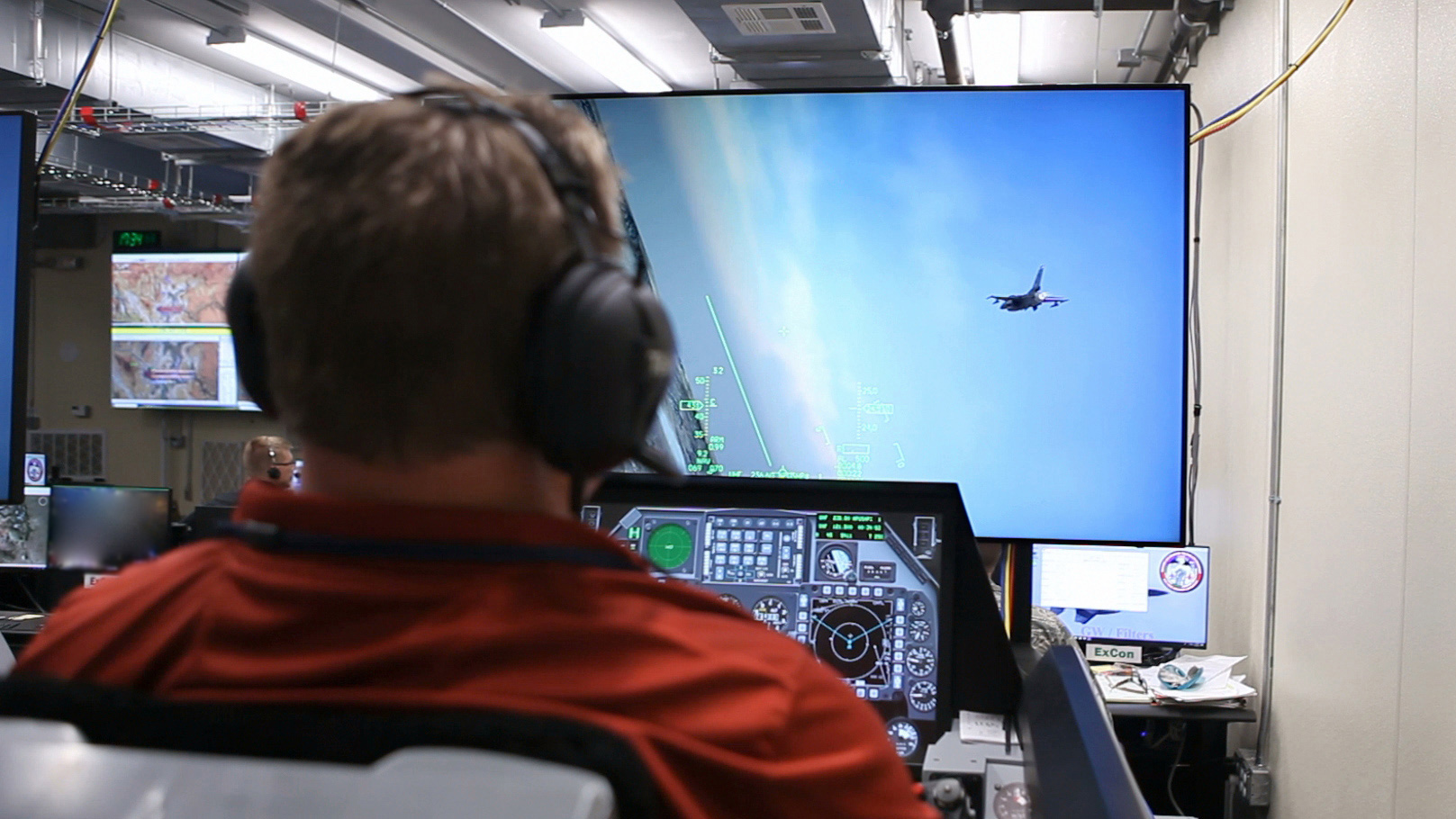
For several years, 26 VRSG licenses have been used in the 711HPW/RHA’s F-16 Deployable Tactics Trainer (DTT) simulators. The F-16 DTTs are deployable, medium fidelity, in-theater training systems for keeping the warfighter proficient between missions. Each simulator consists of an F-16 Block 30 aircraft shell with the actual F-16 Operational Flight Program (OFP) and high-fidelity aircraft stick and throttle. These simulators provide the essential F-16 cockpit switches on a touch-screen LCD in front of the pilot.
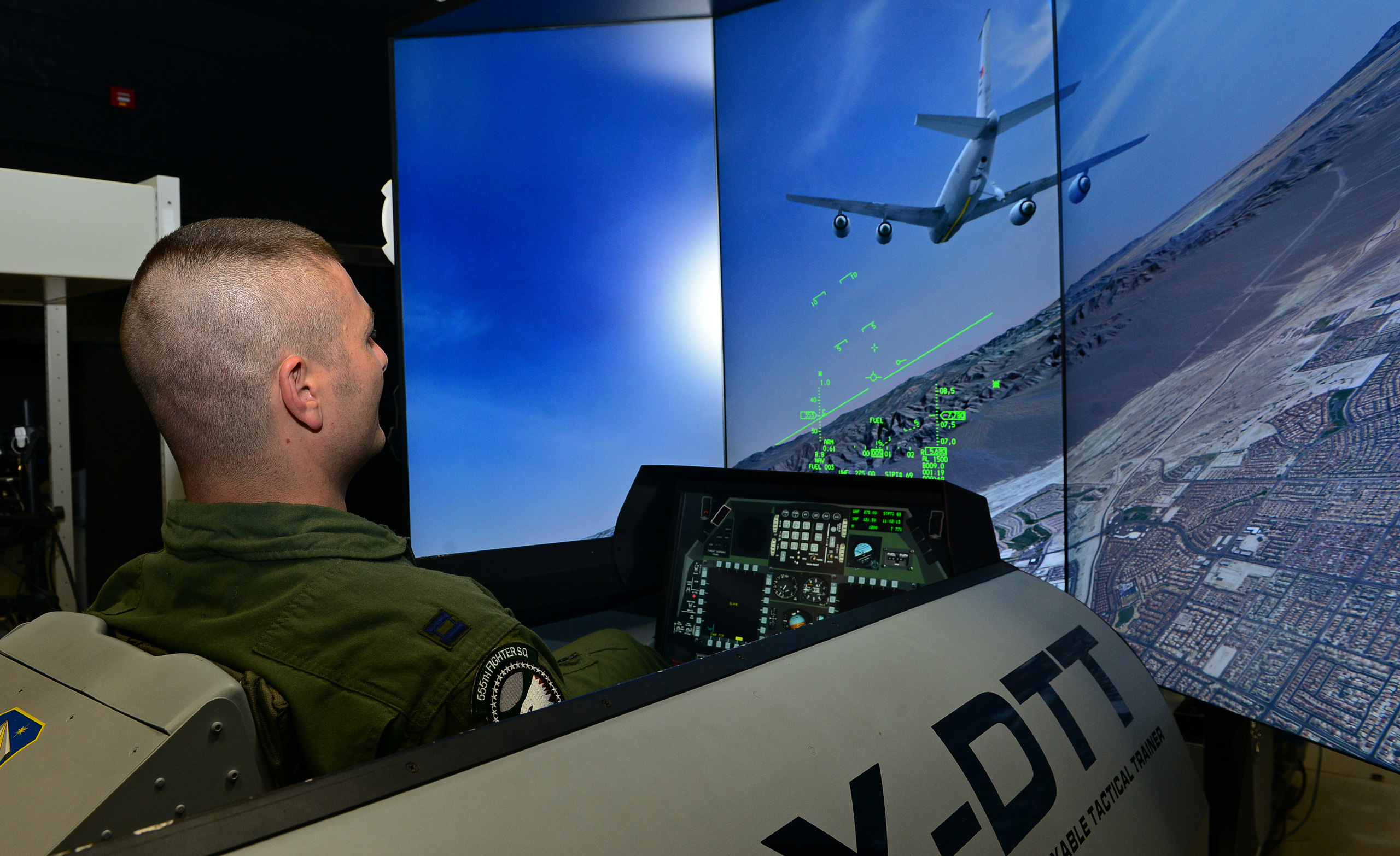
MVRsimulation was chosen to be the image generation supplier for the 309th SMXG European Participating Air Forces (EPAF) program to upgrade the visual systems of Belgian and Portuguese F-16 simulators.
The upgrade calls for up to 40 VRSG licenses, and two Terrain Tools licenses. In addition to supplying round-earth terrain of Europe and CONUS++, MVRsimulation created and delivered five geospecific terrain insets (10 cm, 20 cm) of areas of interest in Belgium and model two geospecific Belgian airfields (Florennes Air Base, Kleine Brogel Air Base) and the Monte Real Air Base in Portugal.
The simulators will be integrated into full mission training (FMT) capability systems used for takeoff/landing, procedural response training, air-to-air and air-to ground tactical training (including weapon employment), and in customized pilot scenario training configured for use in real-time, immersive environments.
The Air Force Reserve Command (AFRC) uses 40 VRSG licenses in two, four-ship AFRC F-16C Block 30 Multi Task Trainers (MTTs) installed at Homestead Air Reserve Base (ARB), FL, and Fort Worth Naval Air Station (NAS) JRB, TX. The F-16C MTT is comprised of a cockpit, an instructor operator station, a 360° field-of-view (FOV) visual display and projection system, VRSG with MVRsimulation’s high-fidelity geospecific terrain and extensive libraries of 3D content, an electronic warfare (EW) threat server, and a host computer/power equipment cabinet. Each F-16C MTT can be operated as a standalone device or linked together to provide four-ship training within the facility or via ARCNET/DTOC/DMO network for participating in distributed exercises.
For each site MVRsimulation built and delivered geospecific terrain with 0.30 mpp imagery of Homestead ARB and Fort Worth NAS JRB blended into 1 mpp CONUS++ imagery, with culture that includes custom runway elevation data to match FAA airfield runway model, runway lights, geospecific control tower, hangars and other geotypical buildings, signs, light poles, and geotypical volumetric trees.
The purpose of the ARFC F-16C MTT program is to provide high-fidelity trainers configured to the latest F-16C Block 30/40 aircraft and capable of training AFRC F-16C pilots in mission qualification, continuation, and mission readiness training tasks.
Luke Air Force Base (AFB) in Glendale, AZ, uses 62 VRSG licenses in their F-16 full-mission training simulators at the base's Network Training Center facility. Each dome-based multi-channel simulator contains a full cockpit replica of an actual F-16C, with VRSG rendering out-the-window (OTW) and sensor views. Luke AFB is a major training base of the Air National Guard’s Air Education and Training Command (AETC) for providing advanced flight training to fighter pilots.
As part of the initial VRSG delivery, MVRsimulation built and delivered high-fidelity geospecific 3D terrain of Luke AFB (KLUF), to include the airfield and the Barry M. Goldwater Range (BMGR) with the East Tactical Range (ETAC) airfield with geographically located 3D models of all of the range targets. The terrain, built from natural color imagery, is in MVRsimulation's round-earth terrain format from natural color imagery. Imagery of the area of Arizona around Luke AFB is 1-meter per-pixel (mpp) resolution, BMGR is 0.50 mpp and the Luke airfield with its immediate on-base surroundings is 0.30 mpp resolution.
Using MVRsimulation visuals, ZedaSoft, Inc. built and delivered a dual-dome reconfigurable F-16 simulator system to Lockheed Martin Advanced Development Programs (ADP) group in support of ACAT/FRRP. The ACAT Fighter Risk Reduction Project program, with a team that includes U.S Air Force Research Laboratory (AFRL) and NASA's Dryden Flight Research Center, develops collision avoidance technologies for fighter/attack aircraft that would reduce the risk of ground and mid-air collisions. This phase tests automatic collision avoidance technologies between USAF fighter aircraft.
The dual-dome solution provides two F-16C Reconfigurable Cockpit Systems (RCS) in high-resolution large field-of-view display and projection systems.
As part of the delivered system MVRsimulation provided a 3D terrain the entire continental United States (CONUS) at 1-meter per-pixel resolution with higher resolution insets for Nellis Air Force Base (AFB), Edwards AFB, and Fort Worth Naval Air Station Joint Reserve Base (NAS JRB) areas.
